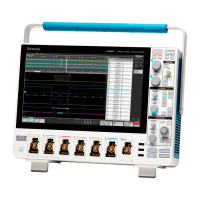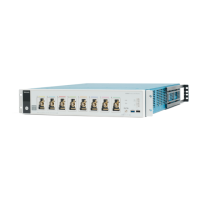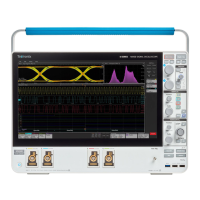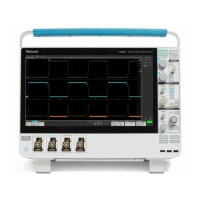Example: [CoefFileName="highpass_0.25bw.flt"]HighPass(Ch1)
CoefFileName is the setting and is used as the high pass filter on channel 1.
Example: [CoefFileName="highpass_0.25bw
.flt"] HighPass(Ch1) + [CoefFileName="lowpass_0.05bw.flt"] LowPass(Ch2)
The high pass filter file is applied to channel 1 and lowpass_0.05bw.flt is applied to channel 2.
Functions, except for basic and logic functions, have the syntax function(source).
In the previous examples the functions are HighPass and LowPass.
Basic and logic functions have the syntax
source1 function source2.
Examples: Ch1 * Ch2
Ch1 AND Ch2
Ch1 >= Ch2
Logic functions, ==|<|>|!=|<=|>=|AND|OR|NAND|NOR|XOR|EQV result in a waveform consisting of binary 0 and 1 values.
Scalars can be integers, floating point values, PI or meas<x>.
Sources can be Ch<x>, Ref<x>, Math<x>
Math waveform differentiation
The math capabilities of the instrument include waveform differentiation. This allows you to display a derivative math waveform that
indicates the instantaneous rate of change of the waveform acquired.
Derivative waveforms are used in the measurement of slew rate of amplifiers and in educational applications. You can create a derivative
math waveform and then use it as a source for another derivative waveform. The result is the second derivative of the waveform that was
first differentiated.
The math waveform, derived from the sampled waveform, is computed based on the following equation:
Yn = (X( n + 1) - Xn) * 1/T
Where: X is the source waveform, Y is the derivative math waveform, and T is the time between samples.
Since the resultant math waveform is a derivative waveform (see the next figure), its vertical scale is in volts/second (its horizontal scale is
in seconds). The source signal is differentiated over its entire record length; therefore, the math waveform record length equals that of the
source waveform.
Measurement concepts
248
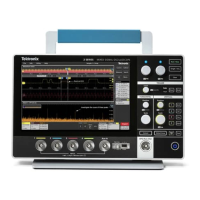
